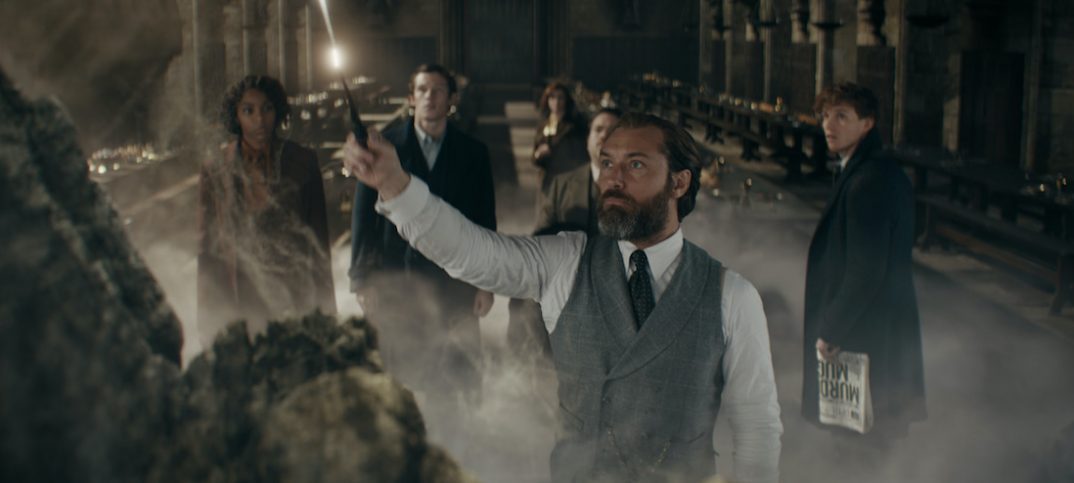Reviewed by Jeffrey Sanzel
In 2011, the Harry Potter franchise concluded with Harry Potter and the Deathly Hallows, Part II. The eight films have grossed over $7.7 billion. So, for this reason alone, it was no surprise when a new series was announced.
In 2016, Potter creator J.K. Rowling penned the screenplay for Fantastic Beasts and Where to Find Them, launching a proposed five-movie arc. Directed by David Yates, the uninspired film was followed by the disastrous mess, Fantastic Beasts: The Crimes of Grindelwald (reviewed in this paper in December 2018).
Now Yates has returned for his third film, Fantastic Beasts: The Secrets of Dumbledore. This time, Rowling has collaborated with writer Steve Kloves. Perhaps it is the addition of the Academy Award-nominated Kloves, but the newest chapter is a vast improvement over its predecessors.
The film opens in 1932, with Magizoologist Newt Scamander (Eddie Redmayne) present for the birth of a Qilin, a magical creature that sees into the soul. Dark wizard Gellert Grindelwald (Madds Mikkelsen, replacing Johnny Depp) has dispatched his acolytes to capture the animal he then murders and reanimates. But, unbeknownst to Grindelwald, the mother had given birth to twins, the second of which Scamander hides in his enchanted suitcase.
The thrust of the action centers on Grindelwald’s campaign for world domination by running for Supreme Mugwump of the International Confederation of Wizards. Future Hogwarts headmaster Albus Dumbledore (Jude Law) has rallied the forces of good to thwart the evil wizard. These include Newt’s brother and Head of the Auror Office, Theseus (Callum Turner); charms professor Eulalie “Lally” Hicks (Jessica Williams); French wizard Yusuf Kama (William Nadylam), who goes undercover; and No-Maj (the American equivalent of Muggle) Jacob Kowalski (Dan Fogler), WWI veteran, baker, and Newt’s friend.
The film begins as a muddle with characters paraded through and multiple threads touched upon but not clarified. Eventually, the plot focuses first on Grindelwald’s acquittal of criminal charges and then on his full-on crusade. His followers are a rabid mob and always on the brink of violence. His rhetoric is the elevation of purebloods and absolute rule over the non-magical (later taken up by Lord Voldemort).
It is no coincidence that much of the film takes place in 1930s Germany. It is not difficult to draw the parallels between Grindelwald and Hitler, his followers and the citizens of that country, and his closest servants, trenchcoated agents suggesting Gestapo. The images are chilling and effective, making the magical world less fantasy, and the heroes need to triumph all the stronger. (There are also more than thinly veiled nods towards recent politics.)
Fantastic Beasts: The Secrets of Dumbledore offers glimpses of the better known Potterverse. Several scenes take place at Hogwarts and the Hog’s Head, the tavern run by Albus’s brother, Aberforth (Richard Coyle). An important plotline involves the Dumbeldore family, connecting them to Credence Barebone (Ezra Miller). Even transfiguration teacher Minerva McGonagall (Fiona Glascott) makes a cameo. The filmmakers are smartly connecting the better-known canon with this burgeoning prequel universe.
Most of the characterizations are broad strokes as the narrative is story driven. However, overall, the performances are strong. Law easily creates a Dumbledore that is knowing and in control, suggesting the Dumbledore he will eventually become. But he also brings shadows of doubt, pain, and regret, enriching the man behind the magic. Mikkelsen makes the villain both cruel and charismatic. The creators did not pull punches on the romantic history between the two, allowing their relationship to inform all their scenes.
Fogler is once again a true delight as Kowalski, a human navigating the wizarding world. Williams’ Lally shows strength and grounding but also mines the role for humor. Turner’s Theseus represents the government agent who understands the big picture, somehow managing to be both stiff and self-aware. Miller brings the right amount of pain and danger to Credence. The weakest link is Redmayne, whose Newt remains a string of stutters and mutterings as if he was more concerned with being precious than present.
The highest praise goes to Stuart Craig and Neil Lamont for the extraordinary production design. Colleen Atwood’s costumes smartly lean towards a dark reality, eschewing the more fanciful dress seen in the Potter films. In addition, the visual and special effects (created by hundreds of artists and craftspeople) are first-rate, whether animating the magic or producing truly fantastic CGI beasts (ranging from the adorable to the horrifying).
The Secrets of Dumbledore breathes life into a series that had neither focus nor purpose before this entry. Hopefully, the production team will build on the film’s integrity and bring Fantastic Beasts to a powerful and welcomed resolution.
Rated PG-13, Fantastic Beasts: The Secrets of Dumbledore is now playing in local theaters.







